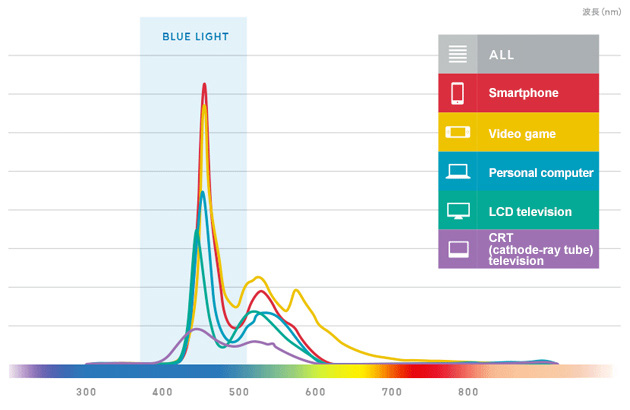What is blue light?
The light with the strongest energy in the visible light spectrum
Blue light is just as its name infers, blue-hued light with a wavelength of 380-500nm (nanometers). Bearing the shortest wavelength of all the rays in the visible spectrum, blue light is characterized by strong energy; it travels unimpeded to the retina without being absorbed by the cornea or crystalline lens of the human eye. Blue light is abundant in LED displays of computers and smartphones, as well as in LED lighting.

When we refer to “light,” we generally mean those electromagnetic waves belonging to the visible light spectrum and thus capable of being seen by the human eye. Wavelengths belonging to the visible light spectrum span 400-800nm (nanometers), with blue light measuring 380-500nm. Wavelengths shorter than 400nm represent ultraviolet rays, while those longer than 700nm signify infrared rays.
Wavelengths of about 350-800nm can permeate the cornea and crystalline lens of our eyes, but electromagnetic waves (light) outside that range cannot. In other words, of all the light reaching the retina, it is blue light which has a strong energy most closely approximating that of ultraviolet rays.
Blue light emitted from digital displays is said to tax our eyes and bodies, with Ministry of Health, Labour, and Welfare Guidelines recommending that “…one continuous operation time must not exceed one (1) hour and an operation downtime of about 15 minutes must be established before subsequent continuous operation.”
The proliferation of LEDs accompanying energy conservation efforts is yielding an increasing exposure to blue light in daily life compared to some 20 years ago. Blue light emission levels differ from one device to another, with cautions extending past the personal computer to embrace that indispensable modern-day item: the smartphone.

Regulating circadian rhythm
The retina of the human eye contains two types of photoreceptor cells: cones, which detect the color of light, and rods, which distinguish changes in light and dark even in low-level light. Recently, a third type of photoreceptor cell has been found, and we have learned that its role is to regulate circadian rhythm.
This third photoreceptor only responds to light with a strong energy of 460nm. In other words, blue light keeps our internal rhythm in check and protects our health, and is thus light bearing an important role.

